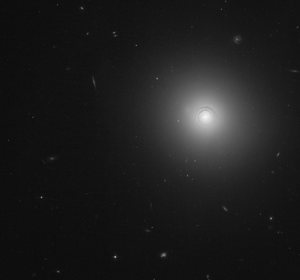NGC 7550
| Galaxy NGC 7550 |
|
|---|---|

|
|
| Image taken with the Hubble Space Telescope | |
| AladinLite | |
| Constellation | Pegasus |
|
Position equinox : J2000.0 , epoch : J2000.0 |
|
| Right ascension | 23 h 15 m 16.0 s |
| declination | + 18 ° 57 ′ 42 ″ |
| Appearance | |
| Morphological type | SA0- / LINER |
| Brightness (visual) | 12.2 mag |
| Brightness (B-band) | 13.2 mag |
| Angular expansion | 1.4 '× 1.2' |
| Position angle | 171 ° |
| Surface brightness | 12.8 mag / arcmin² |
| Physical data | |
| Affiliation | WBL 700 |
| Redshift | 0.016918 ± 0.000067 |
| Radial velocity | (5072 ± 20) km / s |
|
Stroke distance v rad / H 0 |
(235 ± 16) x 10 6 ly (71.9 ± 5.0) Mpc |
| history | |
| discovery | Wilhelm Herschel |
| Discovery date | September 18, 1784 |
| Catalog names | |
| NGC 7550 • UGC 12456 • PGC 70830 • CGCG 454-012 • MCG + 03-59-015 • 2MASX J23151609 + 1857409 • Arp 99 • HCG 93A • GC 4915 • H III 181 • h 2219 • GALEX ASC J231516.08 + 185740.7 • LDCE 1563 NED003 | |
NGC 7550 is an elliptical galaxy with an active nucleus of the Hubble type E / S0 in the constellation Pegasus in the northern sky . It is estimated to be 235 million light years from the Milky Way and about 95,000 light years across. Together with NGC 7549 , it forms the galaxy pair Arp 99 .
Halton Arp organized his catalog of unusual galaxies into groups according to purely morphological criteria. This galaxy belongs to the class spiral galaxies with an elliptical companion on one arm (Arp catalog) . The galaxy pair forms the galaxy group HCG 93 with NGC 7547 , NGC 7553 and NGC 7558 .
The object was discovered by Wilhelm Herschel on September 18, 1784 .
literature
- Jeff Kanipe and Dennis Webb: The Arp Atlas of Peculiar Galaxies - A Chronicle and Observer's Guide , Richmond 2006, ISBN 978-0-943396-76-7
